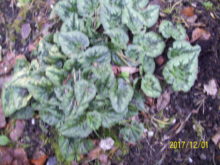November Gardening Tips
Reasons to be cheerful
The shortest day has been and gone and the daily period of light has, almost imperceptibly, increased. The infra-red wavelengths penetrate the soil and activate enzymes, via chemicals called phytochromes, that start seeds and dormant plants growing.
Witch hazel, Sarcococca, Daphne odora and mahonia are just some of the scented lowers you can enjoy now. Wintergreen ferns give a wonderful textured foliage effect in sheltered shady spots, so do the leaves of Cyclamen hederafolia and Pulmonaria. Cyclamen coum flowers in early spring and combines well with winter aconites or snowdrops. (The peak flowering time for most snowdrops is February, but varieties like Galanthus elwessii, G.nivalis and G.woronowii are earlier.)
Jobs to do
Kitchen garden Prune gooseberries, red and white currants to maintain an open centred bush with 8 – 10 main branches – this avoids mildew. Prune last year’s growth by half. Finish winter pruning of fruit trees (except plums and cherries). Continue harvesting winter vegetables like parsnips and Brussels sprouts.
Ornamental garden Start pruning wisteria. The current season’s growth, tamed in July, should be cut back to 2-3 buds from old wood. If the old wood is tangled or overgrown, cut it back to a fork or side branch, maybe back to ground level.
Start cutting old leaves from ornamental grasses to make room for new growth. Also cut off old leaves on hellebores to expose the flowers, unless grown for foliage effect.
Prune winter jasmine when the flowers fade.
Plant deciduous hedges like beech, hornbeam, blackthorn and hawthorn.
Indoors
Feed Christmas flowering Hippeastrum (amaryllis) to build up the bulbs for next year. Start ‘chitting’ early potatoes by placing them in egg-boxes in a cool light position. Sow begonias, lobelia, salvia, pelargonium and sweet peas in pots on a windowsill, cold frame or greenhouse.
A bit of botany!!
I’m not sure if this is being patronising or helpful, but I thought I might untangle some of the mysteries of terminology and some explanations of gardening practices. This month it is….
Bulbs and corms
Bulbs are leaf-bases swollen with sugars stored from the summer. The sugars are used by the plant to put up a flower stalk before the competition shades them; as it does the stores shrink and the ‘empty’ leaf bases form the papery protective coat of the bulb. Bulbs have a very short stem – think of an onion, that conical hard bit with roots at the bottom. Daffodils, tulips and snowdrops have bulbs as well.
Corms are short swollen stems that stay underground with only the leaves and flowers emerging. After flowering a new corm forms on top of the old one, and contractile roots pull the new corm back into the soil. Crocus, cuckoo pint, crocosmia, gladiolus and acidanthera are examples of plants with corms.
November Hints & Tips
November Hints and Tips
After this year’s vagaries of temperature and rainfall, plants have become confused and some are flowering now when they should flower in spring; e.g. the apple blossom at RHS Wisley (not to mention witch hazel and irises in my garden). It is now worth considering the...
November Gardening Tips
The colour of trees in the garden and wider countryside turns to gold, red and bronze, quite lovely on a sunny day. The ground beneath looks gold plated. I am not fastidious about raking leaves up immediately – they will do no harm for several weeks and will provide...
November Gardening
November Gardening by Ewshot Gardener The colour of trees in the garden and wider countryside turns to gold, red and bronze, quite lovely on a sunny day. The ground beneath looks gold plated. I like to rustle through the colourful fallen leaves, so I am not fastidious...


